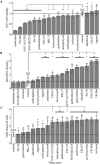In silico Drug Screening Approach Using L1000-Based Connectivity Map and Its Application to COVID-19
- PMID: 35402570
- PMCID: PMC8989014
- DOI: 10.3389/fcvm.2022.842641
In silico Drug Screening Approach Using L1000-Based Connectivity Map and Its Application to COVID-19
Abstract
Conventional drug screening methods search for a limited number of small molecules that directly interact with the target protein. This process can be slow, cumbersome and has driven the need for developing new drug screening approaches to counter rapidly emerging diseases such as COVID-19. We propose a pipeline for drug repurposing combining in silico drug candidate identification followed by in vitro characterization of these candidates. We first identified a gene target of interest, the entry receptor for the SARS-CoV-2 virus, angiotensin converting enzyme 2 (ACE2). Next, we employed a gene expression profile database, L1000-based Connectivity Map to query gene expression patterns in lung epithelial cells, which act as the primary site of SARS-CoV-2 infection. Using gene expression profiles from 5 different lung epithelial cell lines, we computationally identified 17 small molecules that were predicted to decrease ACE2 expression. We further performed a streamlined validation in the normal human epithelial cell line BEAS-2B to demonstrate that these compounds can indeed decrease ACE2 surface expression and to profile cell health and viability upon drug treatment. This proposed pipeline combining in silico drug compound identification and in vitro expression and viability characterization in relevant cell types can aid in the repurposing of FDA-approved drugs to combat rapidly emerging diseases.
Keywords: ACE2; COVID-19; L1000; connectivity map (CMap); drug repurposing; lung epithelial cell.
Copyright © 2022 Asano, Chelvanambi, Decano, Whelan, Aikawa and Aikawa.
Conflict of interest statement
TA is an employee of Kowa Company, Ltd and was a visiting scientist at Brigham and Women's Hospital when experiments demonstrated in this study were performed. The remaining authors declare that the research was conducted in the absence of any commercial or financial relationships that could be construed as a potential conflict of interest.
Figures






Similar articles
-
Gene expression profiles of precursor cells identify compounds that reduce NRP1 surface expression in macrophages: Implication for drug repositioning for COVID-19.Front Cardiovasc Med. 2024 Oct 24;11:1438396. doi: 10.3389/fcvm.2024.1438396. eCollection 2024. Front Cardiovasc Med. 2024. PMID: 39512370 Free PMC article.
-
L1000 connectivity map interrogation identifies candidate drugs for repurposing as SARS-CoV-2 antiviral therapies.Comput Struct Biotechnol J. 2020;18:3947-3949. doi: 10.1016/j.csbj.2020.11.054. Epub 2020 Dec 6. Comput Struct Biotechnol J. 2020. PMID: 33312454 Free PMC article.
-
Different compounds against Angiotensin-Converting Enzyme 2 (ACE2) receptor potentially containing the infectivity of SARS-CoV-2: an in silico study.J Mol Model. 2022 Mar 5;28(4):82. doi: 10.1007/s00894-022-05059-1. J Mol Model. 2022. PMID: 35249180 Free PMC article.
-
Current targets and drug candidates for prevention and treatment of SARS-CoV-2 (COVID-19) infection.Rev Cardiovasc Med. 2020 Sep 30;21(3):365-384. doi: 10.31083/j.rcm.2020.03.118. Rev Cardiovasc Med. 2020. PMID: 33070542 Review.
-
Angiotensin-converting enzyme 2 (ACE2), SARS-CoV-2 and the pathophysiology of coronavirus disease 2019 (COVID-19).J Pathol. 2020 Jul;251(3):228-248. doi: 10.1002/path.5471. Epub 2020 Jun 10. J Pathol. 2020. PMID: 32418199 Free PMC article. Review.
Cited by
-
A multi-omics strategy to understand PASC through the RECOVER cohorts: a paradigm for a systems biology approach to the study of chronic conditions.Front Syst Biol. 2025 Jan 7;4:1422384. doi: 10.3389/fsysb.2024.1422384. eCollection 2024. Front Syst Biol. 2025. PMID: 40809128 Free PMC article. Review.
-
Drug repurposing based on the similarity gene expression signatures to explore for potential indications of quercetin: a case study of multiple sclerosis.Front Chem. 2023 Sep 8;11:1250043. doi: 10.3389/fchem.2023.1250043. eCollection 2023. Front Chem. 2023. PMID: 37744058 Free PMC article.
-
Major Facilitator Superfamily Domain Containing 5 Inhibition Reduces Lipoprotein(a) Uptake and Calcification in Valvular Heart Disease.Circulation. 2024 Jan 30;149(5):391-401. doi: 10.1161/CIRCULATIONAHA.123.066822. Epub 2023 Nov 8. Circulation. 2024. PMID: 37937463 Free PMC article.
-
Computational drug repurposing: approaches, evaluation of in silico resources and case studies.Nat Rev Drug Discov. 2025 Jul;24(7):521-542. doi: 10.1038/s41573-025-01164-x. Epub 2025 Mar 18. Nat Rev Drug Discov. 2025. PMID: 40102635 Review.
-
Gene expression profiles of precursor cells identify compounds that reduce NRP1 surface expression in macrophages: Implication for drug repositioning for COVID-19.Front Cardiovasc Med. 2024 Oct 24;11:1438396. doi: 10.3389/fcvm.2024.1438396. eCollection 2024. Front Cardiovasc Med. 2024. PMID: 39512370 Free PMC article.
References
-
- Jha PK, Vijay A, Halu A, Uchida S, Aikawa M. Gene expression profiling reveals the shared and distinct transcriptional signatures in human lung epithelial cells infected with SARS-CoV-2, MERS-CoV, or SARS-CoV: potential implications in cardiovascular complications of COVID-19. Front Cardiovasc Med. (2021) 7:1–15. 10.3389/fcvm.2020.623012 - DOI - PMC - PubMed
-
- Chelvanambi S, Gupta SK, Chen X, Ellis BW, Maier BF, Colbert TM, et al. . HIV-Nef protein transfer to endothelial cells requires Rac1 activation and leads to endothelial dysfunction: implications for statin treatment in HIV patients. Circ Res. (2019) 125:805–20. 10.1161/CIRCRESAHA.119.315082 - DOI - PMC - PubMed
Grants and funding
LinkOut - more resources
Full Text Sources
Miscellaneous

